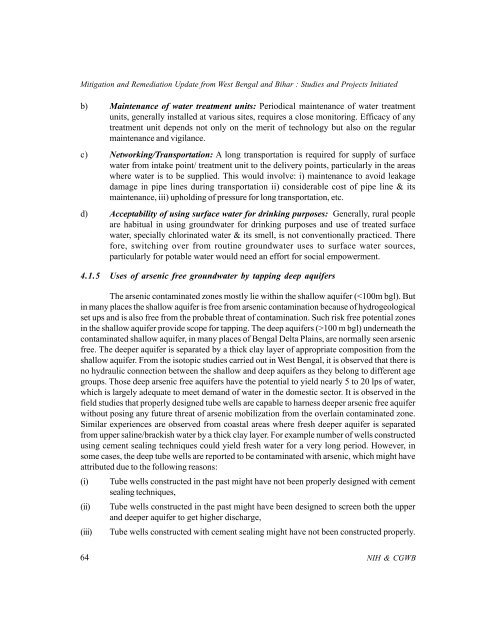Mitigation and Remedy of Groundwater Arsenic Menace in India
Mitigation and Remedy of Groundwater Arsenic Menace in India
Mitigation and Remedy of Groundwater Arsenic Menace in India
You also want an ePaper? Increase the reach of your titles
YUMPU automatically turns print PDFs into web optimized ePapers that Google loves.
<strong>Mitigation</strong> <strong>and</strong> Remediation Update from West Bengal <strong>and</strong> Bihar : Studies <strong>and</strong> Projects Initiatedb) Ma<strong>in</strong>tenance <strong>of</strong> water treatment units: Periodical ma<strong>in</strong>tenance <strong>of</strong> water treatmentunits, generally <strong>in</strong>stalled at various sites, requires a close monitor<strong>in</strong>g. Efficacy <strong>of</strong> anytreatment unit depends not only on the merit <strong>of</strong> technology but also on the regularma<strong>in</strong>tenance <strong>and</strong> vigilance.c) Network<strong>in</strong>g/Transportation: A long transportation is required for supply <strong>of</strong> surfacewater from <strong>in</strong>take po<strong>in</strong>t/ treatment unit to the delivery po<strong>in</strong>ts, particularly <strong>in</strong> the areaswhere water is to be supplied. This would <strong>in</strong>volve: i) ma<strong>in</strong>tenance to avoid leakagedamage <strong>in</strong> pipe l<strong>in</strong>es dur<strong>in</strong>g transportation ii) considerable cost <strong>of</strong> pipe l<strong>in</strong>e & itsma<strong>in</strong>tenance, iii) uphold<strong>in</strong>g <strong>of</strong> pressure for long transportation, etc.d) Acceptability <strong>of</strong> us<strong>in</strong>g surface water for dr<strong>in</strong>k<strong>in</strong>g purposes: Generally, rural peopleare habitual <strong>in</strong> us<strong>in</strong>g groundwater for dr<strong>in</strong>k<strong>in</strong>g purposes <strong>and</strong> use <strong>of</strong> treated surfacewater, specially chlor<strong>in</strong>ated water & its smell, is not conventionally practiced. Therefore, switch<strong>in</strong>g over from rout<strong>in</strong>e groundwater uses to surface water sources,particularly for potable water would need an effort for social empowerment.4.1.5 Uses <strong>of</strong> arsenic free groundwater by tapp<strong>in</strong>g deep aquifersThe arsenic contam<strong>in</strong>ated zones mostly lie with<strong>in</strong> the shallow aquifer (100 m bgl) underneath thecontam<strong>in</strong>ated shallow aquifer, <strong>in</strong> many places <strong>of</strong> Bengal Delta Pla<strong>in</strong>s, are normally seen arsenicfree. The deeper aquifer is separated by a thick clay layer <strong>of</strong> appropriate composition from theshallow aquifer. From the isotopic studies carried out <strong>in</strong> West Bengal, it is observed that there isno hydraulic connection between the shallow <strong>and</strong> deep aquifers as they belong to different agegroups. Those deep arsenic free aquifers have the potential to yield nearly 5 to 20 lps <strong>of</strong> water,which is largely adequate to meet dem<strong>and</strong> <strong>of</strong> water <strong>in</strong> the domestic sector. It is observed <strong>in</strong> thefield studies that properly designed tube wells are capable to harness deeper arsenic free aquiferwithout pos<strong>in</strong>g any future threat <strong>of</strong> arsenic mobilization from the overla<strong>in</strong> contam<strong>in</strong>ated zone.Similar experiences are observed from coastal areas where fresh deeper aquifer is separatedfrom upper sal<strong>in</strong>e/brackish water by a thick clay layer. For example number <strong>of</strong> wells constructedus<strong>in</strong>g cement seal<strong>in</strong>g techniques could yield fresh water for a very long period. However, <strong>in</strong>some cases, the deep tube wells are reported to be contam<strong>in</strong>ated with arsenic, which might haveattributed due to the follow<strong>in</strong>g reasons:(i) Tube wells constructed <strong>in</strong> the past might have not been properly designed with cementseal<strong>in</strong>g techniques,(ii) Tube wells constructed <strong>in</strong> the past might have been designed to screen both the upper<strong>and</strong> deeper aquifer to get higher discharge,(iii) Tube wells constructed with cement seal<strong>in</strong>g might have not been constructed properly.64NIH & CGWB




